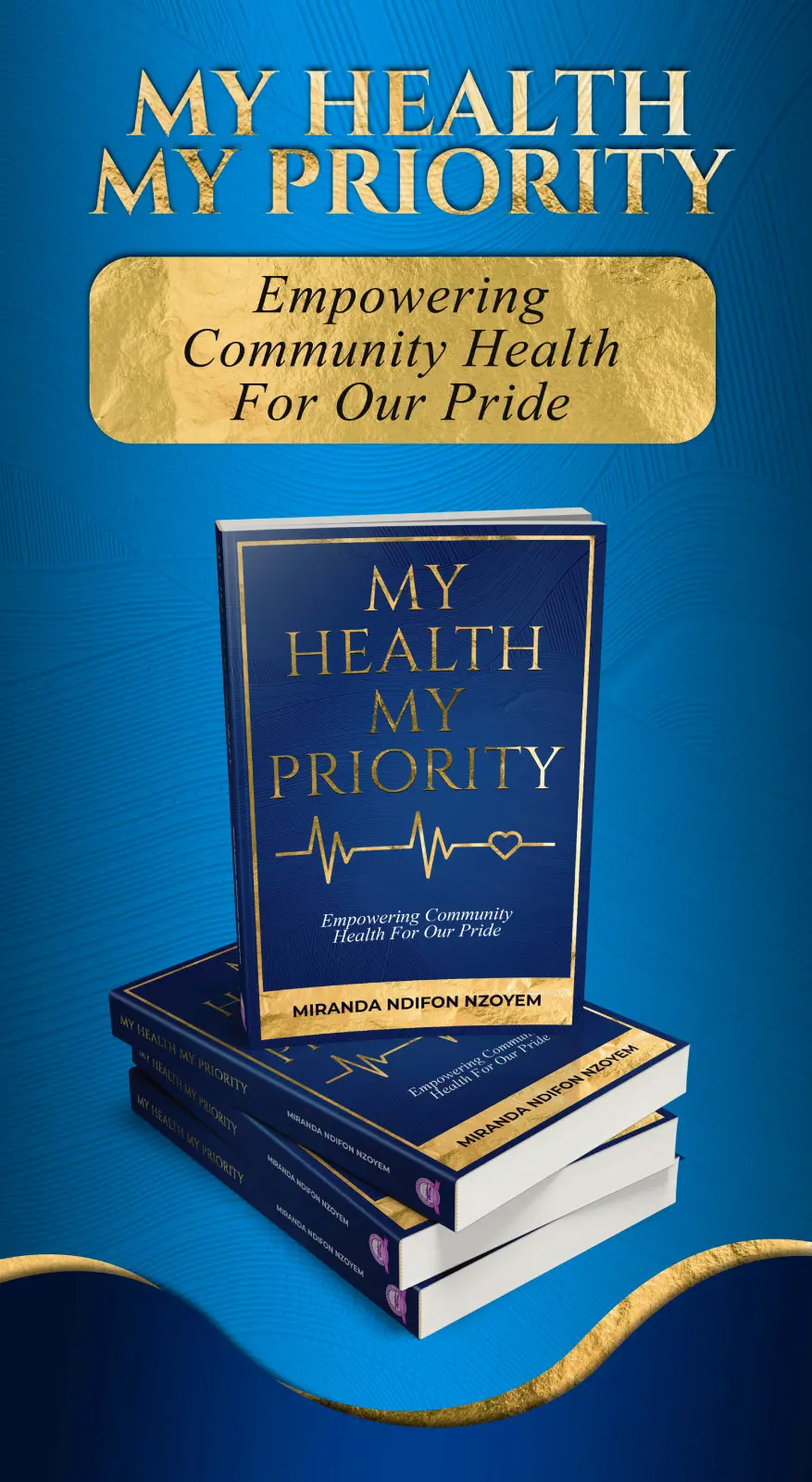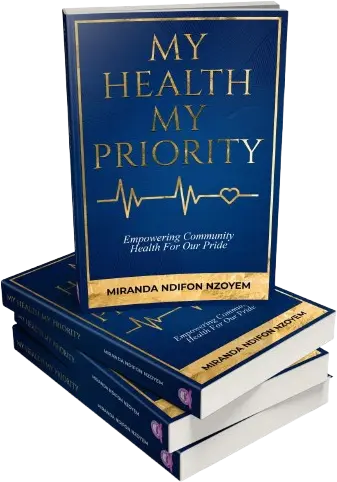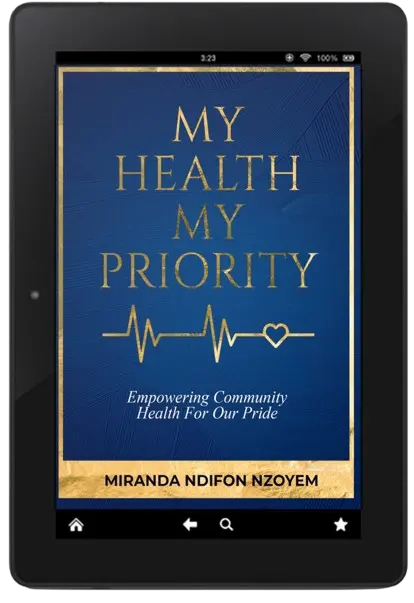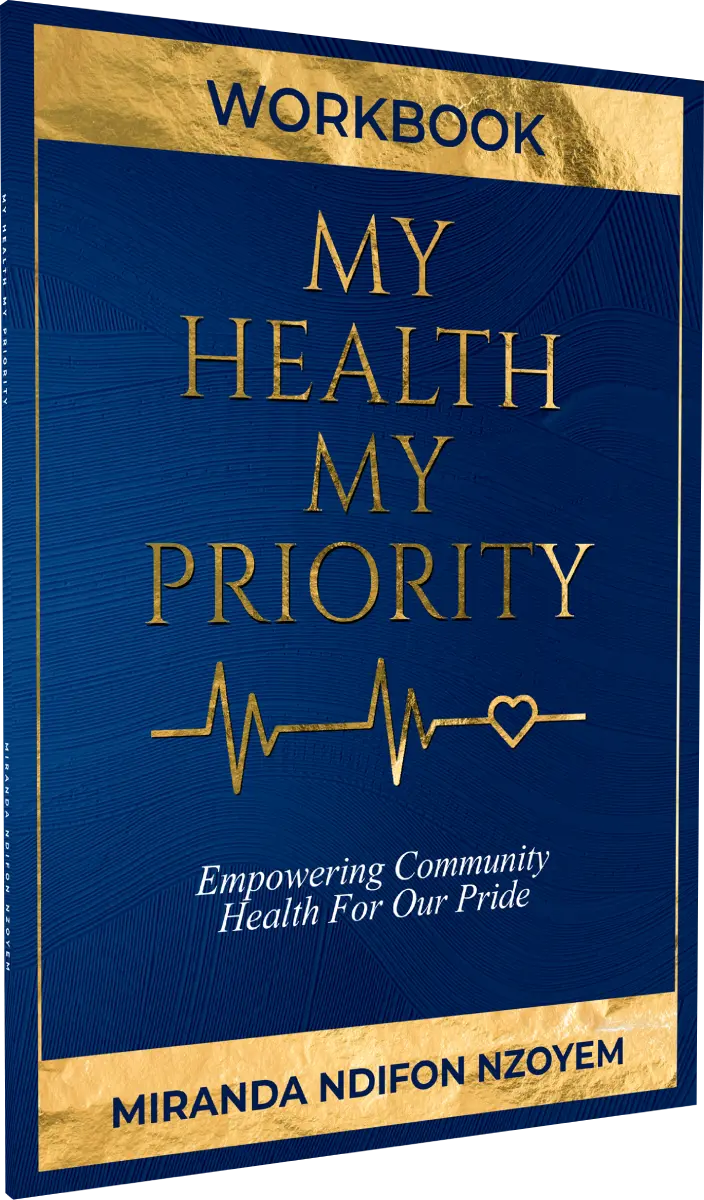My Health My Priority
Empowering Community Health For Our Pride

About the Book


My Health, My Priority: Empowering Community Health for Our Pride is an insightful and transformative health guide that addresses the critical health disparities disproportionately affecting the Black community. Written by healthcare professional and educator Miranda Ndifon Nzoyem, this book serves as both an educational resource and a call to action, encouraging individuals, families, and communities to take charge of their health and well-being.
With a compassionate and practical approach, Miranda explores the underlying socio-economic, cultural, and systemic factors that contribute to poor health outcomes in Black populations. She provides evidence-based strategies for disease prevention, early detection, and health maintenance, covering a wide range of conditions such as hypertension, diabetes, heart disease, cancer, stroke, kidney disease, and mental health challenges.
Divided into four key sections, My Health, My Priority first examines the state of Black health and the role of social determinants, shedding light on the disparities that exist in healthcare access and outcomes. It then delves into preventive care, healthy lifestyle choices, and stress management, offering actionable steps for individuals to safeguard their health. The book also provides disease-specific prevention and management strategies, equipping readers with the knowledge needed to make informed health decisions.
Beyond personal well-being, My Health, My Priority highlights the importance of community engagement and advocacy in promoting health equity. Miranda emphasizes the power of education, early intervention, and collective action in addressing health disparities and building a healthier future for the Black community.
This book is a must-read for anyone seeking to improve their health, advocate for better healthcare access, or empower their community with vital health knowledge. Whether you are a healthcare professional, a caregiver, or simply someone committed to leading a healthier life, My Health, My Priority provides the tools, insights, and motivation needed to create lasting change.

Why this Book?

- Bridging the Health GapHealth disparities continue to affect the Black community at alarming rates. My Health, My Priority is a wake-up call and a practical guide to understanding, managing, and preventing chronic diseases that disproportionately impact our communities.
- Empowering You with KnowledgeMany health issues are preventable with the right information and early intervention. This book simplifies complex medical concepts, offering clear, actionable strategies to help you take charge of your well-being—whether through lifestyle changes, preventive care, or understanding family health history.
- A Culturally Relevant PerspectiveWritten with the unique health challenges of Black individuals and families in mind, this book acknowledges the social, economic, and systemic factors that contribute to health inequities. It provides tailored solutions that are both realistic and effective.
- For Individuals, Families & CommunitiesHealth is a collective effort. Whether you're focusing on your own well-being, supporting a loved one, or advocating for better healthcare access in your community, this book equips you with the tools to make informed decisions and inspire lasting change.
- A Call to Action for a Healthier FutureYour health is your power! By reading this book, you’re not just gaining knowledge—you’re taking a proactive step toward breaking the cycle of preventable diseases and building a healthier, stronger future for yourself and your community.
Who Is This Book For?

- Individuals Committed to Their HealthThis book is for anyone looking to take control of their well-being by understanding preventive care, chronic disease management, and healthy lifestyle choices. Whether you’re struggling with hypertension, diabetes, or simply want to live a healthier life, this guide provides practical steps to empower you.
- Families and CaregiversIf you’re caring for loved ones—whether aging parents, children, or relatives with chronic illnesses—this book equips you with the knowledge and tools to support their health journey. Understanding family health history and early prevention can make a lasting difference in your family’s well-being.
- Healthcare Professionals & AdvocatesFor nurses, community health workers, and anyone passionate about reducing health disparities, this book serves as an essential resource. It provides insights into the challenges faced by the Black community and offers strategies for culturally competent healthcare and advocacy.
- Community Leaders & Policy MakersIf you're involved in public health initiatives, community outreach, or policymaking, this book highlights key social determinants of health and offers actionable solutions to drive change. By addressing systemic barriers, we can create healthier, stronger communities together.
What You'll Achieve by Using This Book?

Take Control of Your Health
Understand & Overcome Health Disparities
Create a Sustainable Healthy Lifestyle
Empower Yourself & Your Community
Take Charge of Your Health Today!

Your health is your greatest asset, and it’s time to make it your priority! The disparities affecting our communities are real, but together, we can break the cycle. Knowledge is power, and by educating yourself, making informed choices, and advocating for better healthcare access, you can take control of your well-being and inspire those around you.
- Read & Apply:Start your journey by reading My Health, My Priority: Empowering Community Health for Our Pride. Learn how to prevent chronic diseases, make healthier lifestyle choices, and take proactive steps toward a better future.
- Share & Educate:Spread the word! Share this book with your family, friends, and community. Health education saves lives, and together, we can close the gap in healthcare disparities.
- Take Action:Commit to regular check-ups, maintain a balanced diet, stay active, and manage stress. Small, consistent changes lead to lifelong wellness.
- Advocate for Change:Join the movement! Support initiatives that promote health equity, get involved in community health programs, and raise awareness about the importance of preventive care.
Your health. Your future. Your priority. Start today—because a healthier you means a stronger, healthier community!
Chapters We've Coverd

Introduction and Background
The introduction outlines the book’s purpose: to address health disparities affecting the Black community and provide practical solutions for disease prevention and health maintenance. Miranda Ndifon Nzoyem shares her motivation for writing the book, shaped by her personal experiences and career as a nurse. She highlights the disproportionate prevalence of chronic diseases like hypertension, diabetes, and heart disease in Black communities, attributing these disparities to socio-economic, cultural, and systemic factors. The introduction also emphasizes the importance of health literacy and preventive care in overcoming these challenges. Readers are encouraged to take charge of their health and become proactive in seeking medical care, maintaining a healthy lifestyle, and advocating for better health resources. The chapter sets the foundation for the book’s comprehensive approach to health, which combines scientific knowledge, cultural awareness, and practical steps for individual and community well-being.
Prologue I: The Quiet Childhood
Miranda recounts her upbringing in Bamenda, Cameroon, where she was a quiet, introspective child shaped by strong community values, religious teachings, and early exposure to health issues. She describes the communal nature of her childhood, where neighbors played a significant role in each other’s lives. Despite being reserved, she found solace in books and learning, which later fueled her passion for healthcare. Her early years were marked by observations of common health misconceptions in her community, such as self-diagnosing illnesses like malaria without medical consultation. These experiences deepened her understanding of the need for proper healthcare education. As she matured, she learned to balance her reserved nature with the need to advocate for herself and others, a skill she would later apply in her medical career. The chapter sets the stage for her journey into the healthcare profession, emphasizing resilience, self-awareness, and the importance of education.
Prologue II: Building a Life of Purpose and Balance
As Miranda transitions into adulthood, she navigates the complexities of balancing love, family, and ambition. She details her journey from a Certified Nursing Assistant (CNA) to a Registered Nurse (RN), highlighting the sacrifices and challenges she faced along the way, including working night shifts while studying and raising a child. Her deep commitment to education and healthcare excellence drives her forward despite the hardships. This chapter also explores the role of mentorship, as Miranda acknowledges key figures who guided her professional growth. Her strong Christian faith remains a cornerstone, providing her with the resilience needed to overcome obstacles. The prologue concludes by emphasizing the importance of perseverance, self-improvement, and staying grounded in one’s values. Miranda’s personal story serves as an inspiration for others striving to achieve their goals despite life’s difficulties.
Chapter 1: The State of Black Health
This chapter provides an in-depth analysis of health disparities affecting Black populations. Miranda presents statistical data showing the higher prevalence of chronic conditions such as hypertension, diabetes, and cardiovascular diseases in the Black community compared to other racial groups. She explores the socio-economic and cultural factors contributing to these disparities, including limited healthcare access, financial constraints, educational gaps, and environmental risks. The impact of systemic racism and healthcare discrimination is also discussed, emphasizing the need for culturally competent healthcare professionals. Additionally, the chapter highlights the barriers Black individuals face in receiving preventive care, leading to delayed diagnoses and worse health outcomes. Miranda advocates for proactive health management through regular screenings, education, and community-driven initiatives to close the gap in healthcare disparities. The chapter serves as a wake-up call to recognize and address these long-standing health inequities.
Chapter 2: The Role of Social Determinants of Health
Miranda discusses how factors such as economic stability, education, social support, and healthcare accessibility influence health outcomes. She explains how poverty, lack of quality education, and high unemployment rates disproportionately impact Black communities, leading to poor health literacy and limited access to healthcare services. Environmental factors, including exposure to pollution and lack of safe spaces for exercise, also contribute to health disparities. The chapter underscores the connection between mental health and physical health, highlighting how chronic stress caused by financial instability, discrimination, and social isolation can lead to serious illnesses. Miranda emphasizes the role of public policy in addressing these issues and calls for community involvement in advocating for better healthcare policies. She concludes with seven key lessons to help individuals and communities prioritize health, stressing the importance of empowerment, education, and collective action.
Chapter 3: The Importance of Preventive Care
This chapter focuses on the power of preventive care in reducing the prevalence of chronic diseases. Miranda explains the importance of regular medical check-ups, screenings, and vaccinations in identifying potential health issues before they become severe. She highlights how lifestyle modifications—such as maintaining a balanced diet, exercising regularly, and managing stress—can significantly lower the risk of developing conditions like heart disease and diabetes. The chapter also addresses common barriers to preventive care, including lack of insurance, mistrust in the medical system, and cultural misconceptions about health. Miranda encourages readers to take proactive steps in monitoring their health by utilizing available community resources and seeking professional medical advice. She stresses that prevention is more effective and less costly than treatment, making it a crucial part of achieving long-term health and well-being.
Chapter 4: Healthy Lifestyle Choices
This chapter emphasizes the role of daily habits in maintaining long-term health. Miranda discusses the impact of diet and nutrition, advocating for balanced meals rich in whole foods while reducing processed and sugary items. She highlights the importance of regular physical activity, explaining how exercise helps manage weight, reduce stress, and prevent chronic illnesses like heart disease and diabetes. Additionally, she warns against harmful habits such as smoking, excessive alcohol consumption, and drug use, emphasizing their long-term health consequences. Miranda provides actionable steps to build and maintain healthy routines, urging consistency and gradual changes over time. She concludes with practical tips for integrating healthier choices into daily life, reinforcing the idea that small, sustained efforts lead to lasting wellness.
Chapter 5: Managing Stress and Mental Health
Miranda highlights the significant impact of stress on physical and mental health, explaining how chronic stress contributes to high blood pressure, heart disease, and weakened immune function. She outlines practical stress management techniques, including mindfulness, meditation, physical exercise, and deep breathing exercises. The chapter also addresses the stigma surrounding mental health in the Black community, encouraging readers to seek professional help when needed. Miranda discusses the importance of a supportive environment, urging families and communities to foster open conversations about mental well-being. She concludes with a set of key lessons to guide readers in prioritizing mental health, reinforcing the idea that emotional well-being is just as crucial as physical health.
Chapter 6: Cardiovascular Diseases
In this chapter, Miranda provides an in-depth look at cardiovascular diseases, which disproportionately affect Black individuals. She discusses hypertension, known as the “silent killer,” and its connection to lifestyle habits, genetics, and stress. The chapter covers heart failure, explaining its symptoms, causes, and management strategies, including dietary adjustments, regular exercise, and medication adherence. Miranda also stresses the importance of monitoring blood pressure at home and staying informed about risk factors. She emphasizes the role of preventive measures, such as regular health screenings and lifestyle modifications, to reduce the risk of cardiovascular complications.
Chapter 7: Cerebral Vascular Diseases (Stroke)
This chapter explores stroke, one of the leading causes of disability and death in the Black community. Miranda explains the warning signs of a stroke, using the FAST (Face drooping, Arm weakness, Speech difficulty, Time to call 911) method to help readers recognize symptoms quickly. She outlines the key risk factors, including high blood pressure, smoking, diabetes, and obesity. The chapter also delves into prevention strategies, such as controlling blood pressure, maintaining a healthy diet, staying active, and avoiding smoking and excessive alcohol consumption. Miranda stresses that education and early action are crucial in reducing stroke-related fatalities and long-term complications.
Chapter 8: Renal Diseases
Miranda discusses the causes and consequences of kidney failure, emphasizing that Black individuals are disproportionately affected by conditions like chronic kidney disease (CKD) and hypertension-related kidney failure. She highlights the importance of early detection, listing warning signs such as fatigue, swelling, and changes in urination. The chapter covers lifestyle adjustments that help prevent kidney disease, including staying hydrated, reducing salt intake, and maintaining a healthy blood pressure. Miranda also explains the role of dialysis and kidney transplants in managing end-stage renal disease, urging early medical intervention to slow disease progression.
Chapter 9: Metabolic and Endocrine Disorders (Diabetes and Obesity)
This chapter focuses on diabetes and obesity, two interconnected conditions that significantly impact the Black community. Miranda explains the types of diabetes, symptoms, and risk factors, including genetics and diet. She offers guidance on blood sugar management through diet, exercise, and medication adherence. The chapter also explores obesity’s role in worsening metabolic health and increasing the risk of diabetes, heart disease, and other chronic illnesses. Miranda provides a step-by-step approach to achieving sustainable weight loss and healthy eating habits, reinforcing the importance of lifestyle changes in disease prevention.
Chapter 10: Chronic and Infectious Diseases
This chapter addresses chronic respiratory diseases like asthma and liver diseases such as cirrhosis, explaining their causes and management strategies. Miranda also covers infectious diseases such as sexually transmitted diseases (STDs) and malaria, emphasizing the importance of early detection, vaccination, and preventive measures. She educates readers on common misconceptions about infectious diseases and encourages routine screenings to detect potential health issues before they become severe.
Chapter 11: Cancer
Miranda discusses the high prevalence of certain cancers in the Black community, including prostate cancer in men and breast cancer in women. She stresses the importance of early detection through screenings like mammograms, Pap smears, and colonoscopies. The chapter explains common treatment options, including surgery, chemotherapy, and radiation therapy. Miranda also highlights the impact of lifestyle factors such as diet, exercise, and smoking on cancer risk, urging readers to adopt habits that lower their chances of developing cancer.
Chapter 12: Family Health History
Understanding family health history is crucial for making informed healthcare decisions. Miranda explains how genetic predisposition plays a role in conditions like diabetes, heart disease, and certain cancers. She provides guidance on how to document and track family medical history, urging readers to share this information with their healthcare providers. The chapter emphasizes the importance of early screenings and preventive measures for individuals at higher risk of hereditary conditions.
Chapter 13: Community Health Initiatives
Community engagement is essential in improving health outcomes. Miranda highlights successful community health programs that provide resources such as free screenings, fitness classes, and nutritional education. She encourages readers to get involved in local health initiatives, volunteer in public health campaigns, and advocate for better healthcare access in underserved communities. The chapter underscores the power of collective action in addressing health disparities and fostering a culture of wellness.
Chapter 14: Your Health, Your Priority
In the final chapter, Miranda reinforces the central message of the book—taking charge of one’s health. She urges readers to implement the healthy habits discussed throughout the book, use available community resources, and advocate for better healthcare access. The chapter also provides a step-by-step guide to creating a personalized health action plan, ensuring long-term commitment to wellness. Miranda concludes with an inspiring call to action, encouraging individuals to prioritize their health and contribute to a healthier, stronger Black community.
Conclusion
Miranda wraps up the book with a powerful message about the importance of commitment to a healthy lifestyle. She encourages readers to apply the knowledge gained and take proactive steps toward their health. The conclusion emphasizes that health is an ongoing journey, and with the right information, support, and mindset, individuals and communities can break through systemic barriers to achieve lasting wellness.
Get Your Copy






